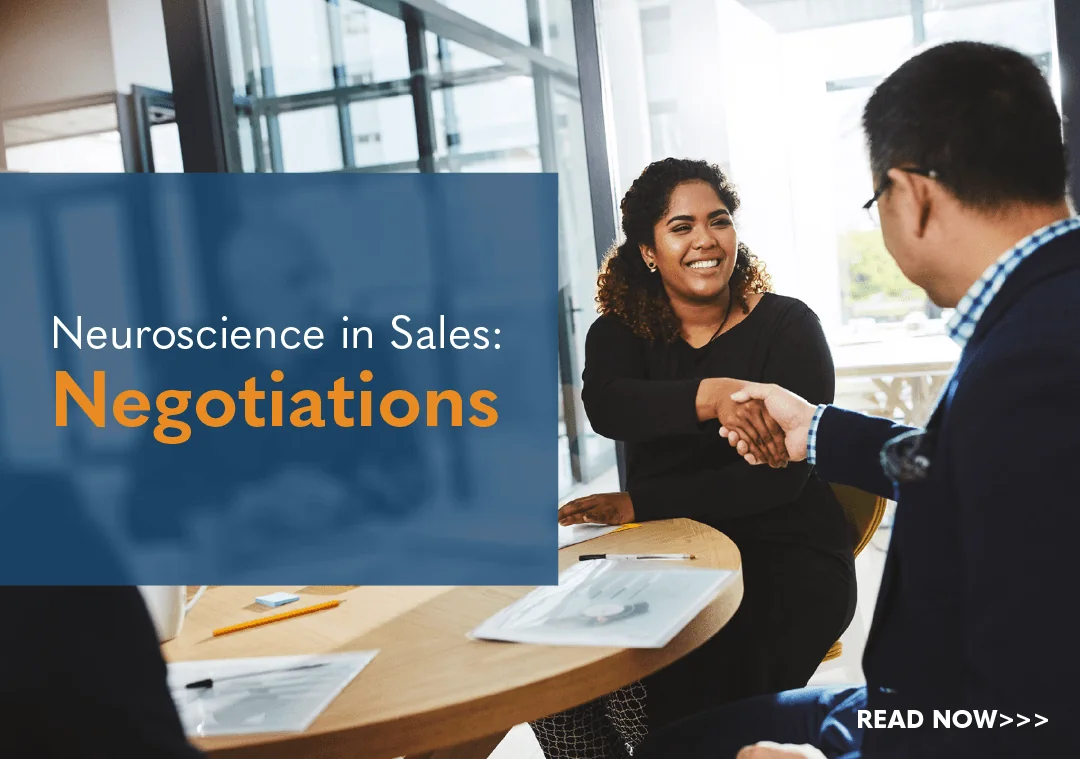Neuroscience in Sales: Negotiations

There’s a surprising amount of research on neuroscience in areas related to sales – it’s becoming a field of increasing interest as companies and academia seek to understand the biomechanics of the buying and selling processes. Today we’ll be looking at how neuroscience applies to negotiations, and how understanding how our brains act during negotiations can make you a better negotiator as a sales professional.
Typically in a negotiation, both parties come in with a set objective they hope to achieve, and the back and forth is inherently set up as a clash of competing goals. But it doesn’t have to be that way – especially since making a negotiation competitive can generate negative feelings – not a good way to go about trying to close a deal. More importantly, as Jeremy Lack noted in a panel presentation to Harvard Law School’s Program on Negotiation, we react to negative experiences more quickly and hold on to them longer – meaning we don’t have enough brain resources for positive experiences. So when you’re arguing with a customer about what price to pay for your service, for example, it’s an adversarial conflict that produces negativity. Even if you close, it can be difficult to maintain the business relationship.
Dan Shapiro, in the same panel, noted that neuroscientific evidence supports the notion that soft skills are effective – and when sales people are aware of that fact, they’re much more likely to act and speak with empathy towards the person they’re negotiating with.
The importance of empathy has also been stated by Gary Noesner, an FBI hostage negotiator for 23 years, who called the process of building trust “the behavioral change stairway”.
The behavioral change stairway model utilizes the following steps (pun wholly intended):
- Active Listening
- Empathy
- Rapport
- Influence
- Behavioral Change
Sound familiar? It should – we’ve written extensively before about the importance of active listening, being empathetic, building rapport with clients, influencing them to make the best decisions for their situation, and being able to effect behavioral change (these same things also apply to sales training and coaching, incidentally).
Following these steps (or walking up the staircase) frequently leads to a mutually beneficial outcome in the negotiation process.
This also involves sales reps getting away from thinking of a negotiation as a zero-sum game, which promotes an adversarial atmosphere because of the belief that gains for one side equals losses for the other side. Instead, sales reps should ask questions to uncover needs – such as what level of support the customer desires – and move away from demands – such as “This is my budget limit and I won’t go beyond that.”
These questions have the added bonus of creating a dialogue and exchange of information, but with a caveat: the information needs to be valuable and relevant to the sales conversation. Which makes the questions a sales rep asks all the more important – they need to be able to unlock the answers that will give the rep insight to how they can best advise the customer. A large research study on negotiation by Clemson University demonstrated the further value in this – finding out important information in negotiation resulted in a larger deal size.
A lot of discussion centers around the importance of reading body language in sales conversations and negotiations. Richard Birke noted that people are “hard-wired to recognize the intent of others by observing and subtly trying on their expressions”. The literature about the value of mirroring prospects in sales negotiations thus has a neuroscience basis (Caveat: If done incorrectly, mirroring back backfire because of the obviousness of the mimicry).
Jared R. Curhan of MIT discovered that people tend to place a higher value on the offers they make, and a lower value on the offers they receive. As a sales rep, being aware of that fact allows you to focus on collaboration, consulting, and advising in negotiations, so that the customer is the one to make the decision and offer to purchase, rather than you as the sales rep proposing the sale.
The Nucleus Accumbens and Its Role in Negotiation
The nucleus accumbens is part of the brain that’s been linked to reward, pleasure, and addiction, and it’s one that’s surprisingly integral in sales negotiations. Why? Because when you frame the negotiation in terms of a positive, collaborative experience, it activates the nucleus accumbens. Especially if you’re able to point out how your offering can either win your customer more money or save it – because winning money has the same pleasure effect as getting high on a biological level.
Another source of activating the nucleus accumbens is engaging in risk-tasking, whereas a different part of the brain, the anterior insula, lights up in a situation of risk-avoidance, as a Stanford university study on the neural basis of financial risk-taking demonstrated. This can be used by sales reps to address different types of buyer personas – more adventurous prospects will be interested in the potential of a product and the chance for reward, whereas more cautious prospects will want to be assured that the risk is minimal – or at least superseded by a guaranteed upside.
Additional Areas of Neuroscience in Sales
According to the article Applying Neuroscience to Sales, this is a quickly growing field. Today, there are several areas in which neuroscience plays an important role in sales. Of course, we do not expect salespeople to become
- Neuromarketing
- Neuroselling
- Neuroleadership
Neuromarketing shows how our brains process information and form emotions. Often, unconscious biases and emotions drive decision-making. Thus, organizations can create campaigns that appeal to subconscious motivations.
Today, through eye-tracking, EEG, and fMRI, neuroselling measures customer reactions and emotions. Knowing these enables sellers to tailor pitches.
Neuroleadership focuses on essential leadership behaviors, including:
- Emotional regulation or managing one’s own and others’ emotions
- Social cognition or understanding and responding to the needs of others.
With emotional regulation, sales managers can keep reps motivated. And through social cognition, managers enable reps to understand a client’s needs.
Sales Training and Development
Insights from neuroscience can help understand a client’s needs and build stronger relationships.
Sales Coaching
Leveraging brain functionality can improve sales coaching. For example, “neuroplasticity” highlights how brains adapt to new experiences. Understanding this can encourage skill development and behavior change.
Further, mindfulness and emotional intelligence can help reps manage their emotions. This can improve communication and build relationships.
Sales Management
Neuroscience can design more effective sales training. Techniques, such as memory retention, aid in recalling product information and basic sales activities and processes. Social cognitive neuroscience can enhance collaboration and communication.
Understanding the brain’s reward system helps sales managers incentivize teams. Rewards tied to specific targets, stimulate the brain’s pleasure centers, boosting motivation and productivity. Positive reinforcement can increase a sales team’s morale and performance.
Boosting Sales with Emotions, Memory, & Tailored Messaging
Often, sales professionals must manage a customer’s emotions. Neuroscience principles, such as mirroring (discussed above), can boost rapport.
In addition, neuroscience can help sellers understand memory. For example, we can only process a limited amount of information at a time. Visual aids, storytelling, and repetition increase engagement and enable more informed decisions.
Plus, neuroscience can help sales professionals tailor messages to individual customers. For example:
- Social proof
- Scarcity
- Framing
As people often follow others, testimonials and case studies are effective forms of social proof.
Scarcity can inspire FOMO, the fear of missing out.
In addition, different perspectives and specific data can “reframe” the perception of products/services.
Product Development
In neuroscience, “cognitive load” is the effort it takes to use a product. Making products easier to use enhances the customer’s experience.
Further, features, such as texture and functionality, stimulate the brain and influence decision making. Understanding neuroscience enables organizations to produce more appealing, efficient, and user-friendly products.
Leveraging Neuroscience in Sales Negotiations
In sales, it’s critical to align the sales process with the customer’s buying journey. This starts with understanding the customer’s needs. And it’s fulfilling that need through each stage of their process.
Today, with customers further along their journey prior to engaging sales reps, sellers must be proactive. They must anticipate needs and guide buyers. Fundamental to this is appreciating how our brains work. The video How Neuroscience Can Power Your Sales Success, offers insights.
As noted by Simon Hazeldine, a sales, negotiation, and leadership consultant, a fundamental human behavior is moving from danger to pleasure. For sellers, this means addressing problems and challenges while emphasizing impact. This includes how solutions affect a buyer’s professional and personal lives.
Neuroscience helps sellers understand and frame a customer’s mindset. For example, having a problem and needing a solution is a negative mindset. Sellers who offer value, including solutions, guide buyers to resolution, a positive mindset. The article How to Negotiate Anything offers some tips to understand how the brain works. These include:
Depersonalize
In neuroscience, the concept of “affect” relates to how our brains generate feelings. Whether pleasant or unpleasant, these feelings arise from our senses.
Socially, we unconsciously regulate each other’s nervous systems. For example, during positive interactions, our heart rates and breathing may synch. In the same way, tense interactions lead to deregulation, such as anxiety and stress.
When this happens, depersonalize the negotiation. You may think a client is having a negative reaction. However, it’s just a jumbled mess of electric signals in your brain. It’s the same for buyers. At best, they too are guessing. Depersonalizing—or not caring what people think—can positively affect the negotiation.
Psychological Preparation
Just as sellers prep for sales interactions, such as knowing the client’s needs, they should psychologically prepare as well.
This starts with basic self-care, getting good sleep, eating well, and hydrating. But it extends into prepping your nerves. Neuroscience suggests engaging in unrelated positive experiences can help. These can include a game, sport, or workout. But it can also be a nice drive or casual conversation.
In addition, familiarize yourself with your surroundings. Negotiating in your own conference room gives you an advantage. This is also true of your favorite coffee shop or restaurant.
Personalized Communication
We all know the dangers of context when texting. It’s too easy to misconstrue a word or phrase. The same is true for email in professional communication, especially negotiations.
Whenever possible, personalized communication can help. This includes:
- In-person
- Videoconference
- Phone calls
Nuance is key. Facial expressions and body language provide the additional context to help understand what’s being said. The same is true of vocal quality. Tone of voice is essential to appreciate subtle distinctions. Thus, personalized communication can benefit a sales negotiation.
A Collaborative Mindset
As we saw earlier, our actions and reactions affect another person’s nervous system. This is also true of the words we use. In this, subtle distinctions can induce positive reactions in sales negotiations.
Words that convey the idea of collaboration and teamwork can help. These align another party’s nervous system with our own. For example, consider:
- We
- Us
- Our
- Collectively
For example, think of the subtle distinctions in the following:
- “I’m glad you agree with me.”
- “I’m grateful we agree.”
The first example conveys opposition. Though the two parties agree, there is the element of competition, “you” vs. “me.” In the second example, the two sides feel more aligned.
Embrace the Silence
Salespeople are often labeled great speakers. Or, worse, it’s assumed they talk a lot. They elucidate, explicate, expound, and explain. Of course, top sellers know the value of active listening over speaking. And neuroscience helps explain it.
Many inexperienced sellers fear silence. With no idea what the other party is thinking, they must that space. However, overexplaining can be detrimental in negotiations. It puts the speaker in a position of power. Thus, buyers may feel intimidated, belittled, or downright bored.
In contrast, silence can be a seller’s friend. Rather than empty space to be filled, it can be a bargaining chip. Like a poker player’s icy stare, silence can convey a seller’s confidence. It also adds weight to what they do say. In this, neuroscience shows the seller is not manipulating the buyer’s emotions. They are, however, guiding its effect on the buyer.
Mixing Neuroscience and Negotiation in Sales
Put all together, it’s clear that neuroscience supports the notion that empathy in negotiations is critical to success in sales. Fostering a collaborative relationship that builds trust and demonstrates value will eliminate the confrontational aspects of zero-sum thinking. The evidence also highlights the importance of information gathering and sharing to facilitate choosing the right offering to find the client needs (with the potential bonus of a larger deal). Sales reps should help the prospect to voice the decision to purchase on their own, and negotiating with customers, ascertain the latter’s personality type to determine whether to highlight the potential reward or the minimal risk associated with a particular purchase.
Elevate your sales negotiation with neuroscience-backed strategies! Learn the power of empathy, effective information sharing, and strategic navigation of personalities. Empower your sales team to guide prospects towards confident purchasing decisions, while strategically navigating personality types for optimal results. Elevate your negotiation skills today and revolutionize your sales approach, talk to an expert!

- Account Planning (11)
- Awards (50)
- Client Testimonial (37)
- Personal Branding (19)
- Podcast (11)
- Research (70)
- Sales Career Development (87)
- Sales Coaching (157)
- Sales Consulting (135)
- Sales Culture (169)
- Sales Enablement (349)
- Sales Leadership (110)
- Sales Management (249)
- Sales Negotiation (16)
- Sales Prospecting (125)
- Sales Role-Playing (19)
- Sales Training (237)
- Selling Strategies (262)
- Soft Skills (68)
- Talent Management (94)
- Trusted Advisor (27)
- Virtual Selling (41)
- Webinar (9)





























